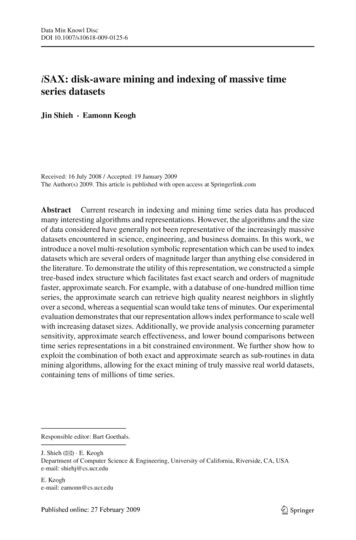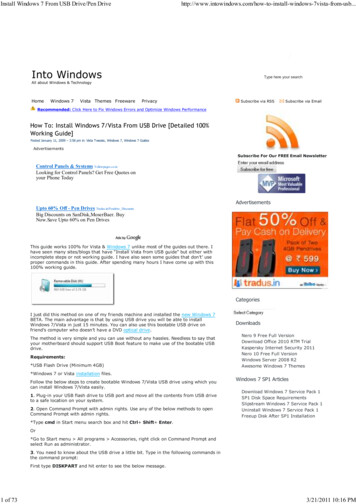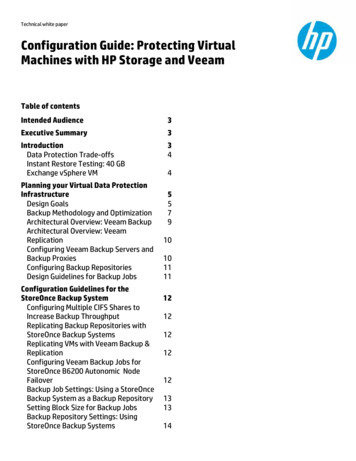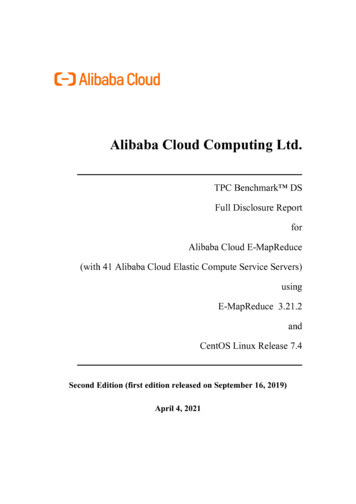
Transcription
Data Min Knowl DiscDOI 10.1007/s10618-009-0125-6iSAX: disk-aware mining and indexing of massive timeseries datasetsJin Shieh · Eamonn KeoghReceived: 16 July 2008 / Accepted: 19 January 2009The Author(s) 2009. This article is published with open access at Springerlink.comAbstract Current research in indexing and mining time series data has producedmany interesting algorithms and representations. However, the algorithms and the sizeof data considered have generally not been representative of the increasingly massivedatasets encountered in science, engineering, and business domains. In this work, weintroduce a novel multi-resolution symbolic representation which can be used to indexdatasets which are several orders of magnitude larger than anything else considered inthe literature. To demonstrate the utility of this representation, we constructed a simpletree-based index structure which facilitates fast exact search and orders of magnitudefaster, approximate search. For example, with a database of one-hundred million timeseries, the approximate search can retrieve high quality nearest neighbors in slightlyover a second, whereas a sequential scan would take tens of minutes. Our experimentalevaluation demonstrates that our representation allows index performance to scale wellwith increasing dataset sizes. Additionally, we provide analysis concerning parametersensitivity, approximate search effectiveness, and lower bound comparisons betweentime series representations in a bit constrained environment. We further show how toexploit the combination of both exact and approximate search as sub-routines in datamining algorithms, allowing for the exact mining of truly massive real world datasets,containing tens of millions of time series.Responsible editor: Bart Goethals.J. Shieh (B) · E. KeoghDepartment of Computer Science & Engineering, University of California, Riverside, CA, USAe-mail: shiehj@cs.ucr.eduE. Keoghe-mail: eamonn@cs.ucr.edu123
J. Shieh, E. KeoghKeywordsTime series · Data mining · Representations · Indexing1 IntroductionThe increasing level of interest in indexing and mining time series data hasproduced many algorithms and representations. However, with few exceptions,the size of datasets considered, indexed, and mined seems to have stalled at themegabyte level. At the same time, improvements in our ability to capture and storedata have lead to the proliferation of terabyte-plus time series datasets. In this work, weshow how a novel multi-resolution symbolic representation called indexableSymbolic Aggregate approXimation (iSAX) can be used to index datasetswhich are several orders of magnitude larger than anything else considered in current literature.The iSAX approach allows for both fast exact search and ultra-fast approximatesearch. Beyond mere similarity search, we show how to exploit the combination ofboth types of search as sub-routines in data mining algorithms, permitting the exactmining of truly massive datasets, with tens of millions of time series, occupying up toa terabyte of disk space.Our approach is based on a modification of the SAX representation to allow extensible hashing (Lin et al. 2007). That is, the number of bits used for evaluation of ourrepresentation can be dynamically changed, corresponding to a desired resolution.An increased number of bits can then be used to differentiate between non-identicalentries. In essence, we show how we can modify SAX to be a multi-resolution representation, similar in spirit to wavelets (Chan and Fu 1999). It is this multi-resolutionproperty that allows us to index time series with zero overlap at leaf nodes as inTS-tree (Assent et al. 2008), unlike R-trees (Guttman 1984), and other spatial accessmethods.As we shall show, our indexing technique is fast and scalable due to intrinsicproperties of the iSAX representation. Because of this, we do not require the useof specialized databases or file managers. Our results, conducted on massive datasets, are all achieved using a simple tree structure which uses the standard WindowsXP NTFS file system for disk access. While it might have been possible to achievefaster times with a sophisticated DBMS, we feel that the simplicity of this approachis a great strength, and will allow easy adoption, replication, and extension of ourwork.A further advantage of our representation is that, being symbolic, it allows the use ofdata structures and algorithms that are not well defined for real-valued data; includingsuffix trees, hashing, Markov models, etc. (Lin et al. 2007). Furthermore, given thatiSAX is a superset of classic SAX, the several dozen research groups that use SAXwill be able to adopt iSAX to improve scalability (Keogh 2008).The rest of the paper is organized as follows. In Sect. 2 we review related work andbackground material. Section 3 introduces the iSAX representation, and Sect. 4 showshow it can be used for approximate and exact indexing. In Sect. 5 we perform a comprehensive set of experiments on both indexing and data mining problems. Finally, inSect. 6 we offer conclusions and suggest directions for future work.123
iSAX: disk-aware mining and indexing of massive time series datasets2 Background and related work2.1 Time series distance measuresIt is increasingly understood that Dynamic Time Warping (DTW) is better than Euclidean Distance (ED) for most data mining tasks in most domains (Xi et al. 2006). It istherefore natural to ask why we are planning to consider Euclidean distance in thiswork. The well documented superiority of DTW over ED is due to the fact that insmall datasets it might be necessary to warp a little to match the nearest neighbor.However, in larger datasets one is more likely to find a close match without the need towarp. As DTW warps less and less, it degenerates to simple ED. This was first notedin Ratanamahatana and Keogh (2005) and later confirmed in Xi et al. (2006) and elsewhere. For completeness, we will show a demonstration of this effect. We measuredthe leave-one-out nearest neighbor classification accuracy of both DTW and ED onincreasingly large datasets containing the CBF and Two-Pat problems, two classictime series benchmarks. Both datasets allow features to warp up to 1/8 the length ofthe sequence, so they may be regarded as highly warped datasets. Figure 1 shows theresult.As we can see, for small datasets, DTW is significantly more accurate than ED.However, as the datasets get larger, the difference diminishes, and by the time thereare mere thousands of objects, there is no measurable difference. In spite of this, andfor completeness, we explain in an online Appendix (Keogh and Shieh 2008) that wecan index under DTW with iSAX with only trivial modifications.2.2 Time series representationsThere is a plethora of time series representations proposed to support similarity searchand data mining. Table 1 shows the major techniques arranged in a hierarchy.Out-of-Sample Error Rate0.030.025EuclideanDTWCBF Dataset0.020.0150.010.00500.50.40.30.20.10Two-Pat Dataset0100020003000400050006000Increasingly Large Training SetsFig. 1 The error rate of DTW and ED on increasingly large instantiations of the CBF and Two-Pat problems.For even moderately large datasets, there is no difference in accuracy123
J. Shieh, E. KeoghTable 1 A hierarchy of timeseries representationsModel basedMarkov ModelsStatistical ModelsTime Series Bitmaps (Kumar et al. 2005)Data adaptivePiecewise PolynomialsInterpolation* (Morinaka et al. 2001)Regression (Shatkay and Zdonik 1996)Adaptive Piecewise Constant Approximation* (Keogh et al. 2001b)Singular Value Decomposition*SymbolicNatural Language (Portet et al. 2007)Strings (Huang and Yu 1999)Non-Lower Bounding (André-Jönsson and Badal 1997;Huang and Yu 1999; Megalooikonomou et al. 2005)SAX* (Lin et al. 2007), iSAX*TreesNon-data adaptiveWavelets* (Chan and Fu 1999)Random Mappings (Bingham and Mannila 2001)SpectralDFT* (Faloutsos et al. 1994)DCT*Chebyshev Polynomials* (Cai and Ng 2004)Piecewise Aggregate Approximation* (Keogh et al. 2001a)IPLA* (Chen et al. 2007)Data dictatedClipped Data* (Bagnall et al. 2006)Those representations annotated with an asterisk have the very desirable propertyof allowing lower bounding. That is to say, we can define a distance measurement onthe reduced abstraction that is guaranteed to be less than or equal to the true distancemeasured on the raw data. It is this lower bounding property that allows us to usea representation to index the data with a guarantee of no false dismissals (Faloutsoset al. 1994). The list of such representations includes (in approximate order of introduction) the discrete Fourier transform (DFT) (Faloutsos et al. 1994), the discreteCosine transform (DCT), the discrete Wavelet transform (DWT), Piecewise AggregateApproximation (PAA) (Keogh et al. 2001a), Adaptive Piecewise Constant Approximation (APCA), Chebyshev Polynomials (CHEB) (Cai and Ng 2004) and IndexablePiecewise Linear Approximation (IPLA) (Chen et al. 2007). We will provide the firstempirical comparison of all these techniques in Sect. 5.The only lower bounding omissions from our experiments are the eigenvalue analysis techniques such as SVD and PCA. While such techniques give optimal linear123
iSAX: disk-aware mining and indexing of massive time series datasetsdimensionality reduction, we believe they are untenable for massive datasets. Forexample, while Steinbach et al. (2003) notes that they can transform 70,000 timeseries in under 10 min, this assumes the data can fit in main memory. However, totransform all the out-of-core (disk resident) datasets we consider in this work, SVDwould require several months.There have been several dozen research efforts that propose to facilitate time seriessearch by first symbolizing the raw data (André-Jönsson and Badal 1997; Huang andYu 1999; Megalooikonomou et al. 2005). However, in every case, the authors introduced a distance measure defined on the newly derived symbols. This allows falsedismissals with respect to the original data. In contrast, the proposed work uses thesymbolic words to internally organize and index the data, but retrieves objects withrespect to the Euclidean distance on the original raw data. This point is importantenough to restate. Although our proposed representation is an approximation to theoriginal data, and whose creation requires us to make a handful of parameters choices,under any parameter set the exact search algorithm introduced in Table 6 is guaranteedto find the true exact nearest neighbor.2.3 Review of classic SAXThe SAX representation was introduced in 2003, since then it has been used by morethan 50 groups worldwide to solve a large variety of time series data mining problems(Lin et al. 2007; Keogh 2008). For concreteness, we begin with a review of it (Linet al. 2007). In Fig. 2 (left) we illustrate a short time series T, which we will use as arunning example throughout this paper.Figure 2 (right) shows our sample time series converted into a representation calledPAA (Keogh et al. 2001a). PAA represents a time series T of length n in a w-dimensional space by a vector of real numbers, T̄ t 1 , . . . , t w . The ith element of T̄ iscalculated by the equation:wt i nnwi Tjj wn (i 1) 132A time series TPAA(T,4)10-1-2-304812160481216Fig. 2 (left) A time series T, of length 16. (right) A PAA approximation of T, with 4 segments123
J. Shieh, E. KeoghIn the case that n is not divisible by w; the summation can be modified to adoptfractional values. This is illustrated in Lin et al. (2007).PAA is a desirable intermediate representation as it allows for computationally fastdimensionality reduction, provides a distance measure which is lower bounding, andhas been shown to be competitive with other dimensionality reduction techniques. Inthis case, the PAA representation reduces the dimensionality of the time series, from16 to 4. The SAX representation takes the PAA representation as an input and discretizes it into a small alphabet of symbols with a cardinality of size a. The discretizationis achieved by imagining a series of breakpoints running parallel to the x-axis andlabeling each region between the breakpoints with a discrete label. Any PAA valuethat falls within that region can then be mapped to the appropriate discrete value.While the SAX representation supports arbitrary breakpoints, we can ensure almostequiprobable symbols within a SAX word if we use a sorted list of numbers,Br eakpoints β1 , . . . , βa 1 such that the area under a N(0,1) Gaussian curve fromβi to βi 1 1/a (β0 and βa are defined as and , respectively). Table 2 showsa table for such breakpoints for cardinalities from 2 to 8.A SAX word is simply a vector of discrete symbols. We use a boldface letter to differentiate between a raw time series and its SAX version, and we denote the cardinalityof the SAX word with a superscript:SAX(T, w, a) Ta {t1 , t2 , . . . , tw 1 , tw }In previous work, we represented each SAX symbol as a letter or integer. Herehowever, we will use binary numbers for reasons that will become apparent later. Forexample, in Fig. 3 we have converted a time series T of length 16 to SAX words.Both examples have a word length of 4, but one has a cardinality of 4 and the otherhas a cardinality of 2. We therefore have SAX(T, 4, 4) T4 {11, 11, 01, 00} andSAX(T, 4, 2) T2 {1, 1, 0, 0}.The astute reader will have noted that once we have T4 we can derive T2 simplyby ignoring the trailing bits in each of the four symbols in the SAX word. As one canreadily imagine, this is a recursive property. For example, if we convert T to SAX witha cardinality of 8, we have SAX(T, 4, 8) T8 {110, 110, 011, 000}. From this, weTable 2 SAX breakpointsβia2β10.00β2β3β4β5β6β7123345678 0.43 0.67 0.84 0.97 1.07 1.150.430.00 0.25 0.43 0.57 0.670.670.250.00 0.18 0.320.840.430.180.000.970.570.321.070.671.15
iSAX: disk-aware mining and indexing of massive time series datasets3210-1-2-304812016481216Fig. 3 A time series T converted into SAX words of cardinality 4 {11, 11, 01, 00} (left), and cardinality 2{1, 1, 0, 0} (right)Table 3 It is possible to obtaina reduced (by half) cardinalitySAX word simply by ignoringtrailing bitsSAX(T, 4, 16) T16 {1100, 1101, 0110, 0001}SAX(T, 4, 8) T8 {110, 110, 011, 000}SAX(T, 4, 4) T4 {11, 11, 01, 00}SAX(T, 4, 2) T2 {1, 1, 0, 0}can convert to any lower resolution that differs by a power of two, simply by ignoringthe correct number of bits. Table 3 makes this clearer.As we shall see later, this ability to change cardinalities on the fly is a useful andexploitable property.Given two time series T and S, their Euclidean distance is: n (Ti Si )2D(T, S) i 1If we have a SAX representation of these two time series, we can define a lowerbounding approximation to the Euclidean distance as: w n MINDIST T2 , S2 (dist (ti , si ))2wi 1This function requires calculating the distance between two SAX symbols and can beachieved with a lookup table, as in Table 4.Table 4 A SAX dist lookuptable for a 0123
J. Shieh, E. KeoghThe distance between two symbols can be read off by examining the correspondingrow and column. For example, dist (00, 01) 0 and dist (00, 10) 0.67.For clarity, we will give a concrete example of how to compute this lower bound.Recall our running example time series T which appears in Fig. 2. If we create a timeseries S that is simply T’s mirror image, then the Euclidean distance between them isD(T, S) 46.06.As we have already seen, SAX(T, 4, 4) T4 {11, 11, 01, 00}, and thereforeSAX(S, 4, 4) S4 {00, 01, 11, 11}. The invocation of the MINDIST function willmake calls to the lookup table shown in Table 4 to find:dist (t1 , s1 ) dist (11, 00) 1.34dist (t2 , s2 ) dist (11, 01) 0.67dist (t3 , s3 ) dist (01, 11) 0.67dist (t4 , s4 ) dist (00, 11) 1.34Which, when plugged into the MINDIST function, gives: 16 2 2MINDIST T , S 1.342 0.672 0.672 1.3424Tightness of lower bound to produce a lower bound value of 4.237. In this case, the lower bound is quiteloose; however, having either more SAX symbols or a higher cardinality will producea tighter lower bound. It is instinctive to ask how tight this lower bounding function canbe, relative to natural competitors like PAA or DWT. This depends on the data itselfand the cardinality of the SAX words, but coefficient for coefficient, it is surprisinglycompetitive with the other approaches. To see this, we can measure the tightness of thelower bounds, which is defined as the lower bounding distance over the true distance(Keogh et al. 2001a). Figure 4 shows this for random walk time series of length 256,with eight PAA or DWT coefficients and SAX words also of length eight. We variedthe cardinality of SAX from 2 to 256, whereas PAA/DWT used a constant 4 bytesper coefficient. The results have been averaged over 10,000 random walk time 0200250Cardinality of SAX wordsFig. 4 The tightness of lower bounds for increasing SAX cardinalities, compared to a PAA/DWTbenchmark123
iSAX: disk-aware mining and indexing of massive time series datasetsThe results show that for small cardinalities the SAX lower bound is quite weak,but for larger cardinalities it rapidly approaches that of PAA/DWT. At the cardinalityof 256, which take 8 bits, the lower bound of SAX is 98.5% that of PAA/DWT, but thelatter requires 32 bits. This tells us that if we compare representations, coefficient forcoefficient, there is little to choose between them; but if we do bit-for-bit comparisons(cf. Sect. 5), SAX allows for much tighter lower bounds. This is one of the propertiesof SAX that can be exploited to allow ultra-scalable indexing.3 The iSAX representationBecause it is tedious to write out binary strings, previous uses of SAX had integers oralphanumeric characters representing SAX symbols (Lin et al. 2007). For example:SAX(T, 4, 8) T8 {110, 110, 011, 000} {6, 6, 3, 0}However, this can make the SAX word ambiguous. If we see just the SAX word {6,6, 3, 0} we cannot be sure what the cardinality is (although we know it is at least 7).Since all previous uses of SAX always used a single “hard-coded” cardinality, this hasnot been an issue. However, the fundamental contribution of this work is to show thatSAX allows the comparison of words with different cardinalities, and even differentcardinalities within a single word. We therefore must resolve this ambiguity. We dothis by writing the cardinality as a superscript. For example, in the example above:iSAX(T, 4, 8) T8 {68 , 68 , 38 , 08 }Because the individual symbols are ordinal, exponentiation is not defined for them, sothere is no confusion in using superscripts in this context. Note that we are now usingiSAX instead of SAX for reasons that will become apparent in a moment.We are now ready to introduce a novel idea that will allow us to greatly expand theutility of iSAX.3.1 Comparing different cardinality iSAX wordsIt is possible to compare two iSAX words of different cardinalities. Suppose we havetwo time series, T and S, which have been converted into iSAX words:iSAX(T, 4, 8) T8 {110, 110, 011, 000} {68 , 68 , 38 , 08 }iSAX(S, 4, 2) S2 {0, 0, 1, 1} {02 , 02 , 12 , 12 }We can find the lower bound between T and S, even though the iSAX words thatrepresent them are of different cardinalities. The trick is to promote the lower cardinality representation into the cardinality of the larger before giving it to the MINDISTfunction. We can think of the tentatively promoted S2 word as S8 {01 , 02 , 1 3 , 14 },then the question is simply what are correct values of the missing i bits? Note that123
J. Shieh, E. Keoghboth cardinalities can be expressed as the power of some integer. This guarantees anoverlap in the breakpoints used during SAX computation. More concretely, if we havean iSAX cardinality of X, and an iSAX cardinality of 2X, then the breakpoints of theformer are a proper subset of the latter. This is shown in Fig. 3.Using this insight, we can obtain the missing bit values in S8 by examining eachposition and computing the bit values at the higher cardinality which are enclosed bythe known bits at the current (lower) cardinality and returning the one which is closestin SAX space to the corresponding value in T8 .This method obtains the S8 representation usable for MINDIST calculations:S8 {011, 011, 100, 100}It is important to note that this is not necessarily the same iSAX word we wouldhave gotten if we had converted the original time series S. We cannot undo a lossycompression. However, using this iSAX word does give us an admissible lower bound.Finally, note that in addition to comparing iSAX words of different cardinalities,the promotion trick described above can be used to compare iSAX words whereeach word has mixed cardinalities. For example, we can allow iSAX words such as{111, 11, 101, 0} {78 , 34 , 58 , 02 }. If such words exist, we can simply align the twowords in question, scan across each pair of corresponding symbols, and promote thesymbol with lower cardinality to the same cardinality as the larger cardinality symbol.In the next section, we explain why it is useful to allow iSAX words with differentcardinalities.4 iSAX indexing4.1 The intuition behind iSAX indexingAs it stands, it may appear that the classic SAX representation offers the potential tobe indexed. We could choose a fixed cardinality of, say, 8 and a word length of 4, andthus have 84 separate labels for files on disk. For instance, our running example T mapsto {68 , 68 , 38 , 08 } under this scheme, and would be inserted into a file that has thisinformation encoded in its name, such as 6.8 6.8 3.8 0.8.txt. The query answeringstrategy would be very simple. We could convert the query into a SAX word with thesame parameters, and then retrieve the file with that label from disk. The time seriesin that file are likely to be very good approximate matches to the query. In order tofind the exact match, we could measure the distance to the best approximate match,then retrieve all files from disk whose label has a MINDIST value less than the valueof the best-so-far match. Such a methodology clearly guarantees no false dismissals.This scheme has a fatal flaw, however. Suppose we have a million time series toindex. With 4,096 possible labels, the average file would have 244 time series in it, areasonable number. However, this is the average. For all but the most contrived datasets we find a huge skew in the distribution, with more than half the files being empty,and the largest file containing perhaps 20% of the entire dataset. Either situation isundesirable for indexing, in the former case, if our query maps to an empty file, we123
iSAX: disk-aware mining and indexing of massive time series datasetswould have to do some ad-hoc trick (perhaps trying “misspellings” of the query label)in order to get the first approximate answer back. In the latter case, if 20% of the datamust be retrieved from disk, then we can be at most five times faster than sequentialscan. Ideally, we would like to have a user defined threshold th, which is the maximumnumber of time series in a file, and a mapping technique that ensures each file hasat least one and at most th time series in it. As we shall now see, iSAX allows us toguarantee exactly this.iSAX offers a multi-resolution, bit aware, quantized, reduced representation withvariable granularity. It is this variable granularity that allows us to solve the problem above. Imagine that we are in the process of building the index and have chosenth 100. At some point there may be exactly 100 time series mapped to the iSAXword {24 , 34 , 34 , 24 }. If, as we continue to build the index, we find another time seriesmaps here, we have an overflow, so we split the file. The idea is to choose one iSAXsymbol, examine an additional bit, and use its value to create two new files. In this case:Original File: {24 , 34 , 34 , 24 } splits into Childfile1 :{48 , 34 , 34 , 24 }Childfile2 :{58 , 34 , 34 , 24 }Note that in this example we split on the first symbol, promoting the cardinalityfrom 4 to 8. For some time series in the file, the extra bit in their first iSAX symbolwas a 0, and for others it was a 1. In the former case, they are remapped to Child1, and in the latter, remapped to Child 2. The child files can be named with someprotocol that indicates their variable cardinality, for example 5.8 3.4 3.4 2.4.txt and4.8 3.4 3.4 2.4.txt.The astute reader will have noticed that the intuition here is very similar to theclassic idea of extensible hashing. This in essence is the intuition behind building aniSAX index, although we have not explained how we decide which symbol is chosenfor promotion and some additional details. In the next sections, we formalize thisintuition and provide details on algorithms for approximately and exactly searchingan iSAX index.4.2 iSAX index constructionAs noted above, a set of time series represented by an iSAX word can be split into twomutually exclusive subsets by increasing the cardinality along one or more dimensions. The number of dimensions d and word length, w, 1 d w, provide an upperbound on the fan-out rate. If each increase in cardinality per dimension follows theassumption of iterative doubling, then the alignment of breakpoints contains overlapsin such a way that hierarchical containment is preserved between the common iSAXword and the set of iSAX words at the finer granularity. Specifically, in iterative doubling, the cardinality to be used after the ith increase in granularity is in accordancewith the following sequence, given base cardinality b : b 2i . The maximum fan-outrate under such an assumption is 2d .123
J. Shieh, E. Keoghroot{Internal nodes}{[]}[[[]]]{}Terminal nodes{}{}Fig. 5 An illustration of an iSAX indexThe use of iSAX allows for the creation of index structures that are hierarchical,containing non-overlapping regions (Assent et al. 2008) (unlike R-trees etc., Faloutsoset al. 1994), and a controlled fan-out rate. For concreteness, we depict in Fig. 5 a simple tree-based index structure which illustrates the efficacy and scalability of indexingusing iSAX.The index is constructed given base cardinality b, word length w, and thresholdth (b is optional; it can be defaulted to 2 or be set for evaluation to begin at highercardinality). The index structure hierarchically subdivides the SAX space, resultingin differentiation between time series entries until the number of entries in each subspace falls below th. Such a construct is implemented using a tree, where each noderepresents a subset of the SAX space such that this space is a superset of the SAXspace formed by the union of its descendents. A node’s representative SAX space iscongruent with an iSAX word and evaluation between nodes or time series is donethrough comparison of iSAX words. The three classes of nodes found in a tree andtheir respective functionality are described below:4.2.1 Terminal nodeA terminal node is a leaf node which contains a pointer to an index file on disk with rawtime series entries. All time series in the corresponding index file are characterized bythe terminal node’s representative iSAX word. A terminal node represents the coarsestgranularity necessary in SAX space to enclose the set of contained time series entries.In the event that an insertion causes the number of time series to exceed th, the SAXspace (and node) is split to provide additional differentiation.4.2.2 Internal nodeAn internal node designates a split in SAX space and is created when the numberof time series contained by a terminal node exceeds th. The internal node splits theSAX space by promotion of cardinal values along one or more dimensions as perthe iterative doubling policy. A hash from iSAX words (representing subdivisions ofthe SAX space) to nodes is maintained to distinguish differentiation between entries.123
iSAX: disk-aware mining and indexing of massive time series datasetsTime series from the terminal node which triggered the split are inserted into thenewly created internal node and hashed to their respective locations. If the hash doesnot contain a matching iSAX entry, a new terminal node is created prior to insertion,and the hash is updated accordingly. For simplicity, we employ binary splits along asingle dimension, using round robin to determine the split dimension.4.2.3 Root nodeThe root node is representative of the complete SAX space and is similar in functionality to an internal node. The root node evaluates time series at base cardinality,that is, the granularity of each dimension in the reduced representation is b. Encountered iSAX words correspond to some terminal or internal node and are used to directindex functions accordingly. Un-encountered iSAX words during inserts result in thecreation of a terminal node and a corresponding update to the hash table.4.2.4 Index insertionPseudo-code of the insert function used for index construction is shown in Table 5.Given a time series to insert, we first obtain the iSAX word representation using therespective iSAX parameters at the current node (line 2). If the hash table does not yetcontain an entry for the iSAX word, a terminal node is created to represent the relevantSAX space, and the time series is inserted accordingly (lines 22–24). Otherwise, thereis an entry in the hash table, and the corresponding node is fetched. If this node is anTable 5 iSAX index insertion unction Insert(ts)iSAX word iSAX(ts, this.parameters)if Hash.ContainsKey(iSAX word)node Hash.ReturnNode(iSAX word)if node is terminalif SplitNode() falsenode.Insert(ts)elsenewnode new internalnewnode.Insert(ts)foreach ts in nodenewnode.Insert(ts)endHash.Remove(iSAX word, node)Hash.Add(iSAX word, newnode)endifelseif node i
mining of truly massive datasets, with tens of millions of time series, occupying up to a terabyte of disk space. Our approach is based on a modification of the SAX representation to allow exten-sible hashing (Lin et al. 2007). That is, the number of bits used for evaluation of our










